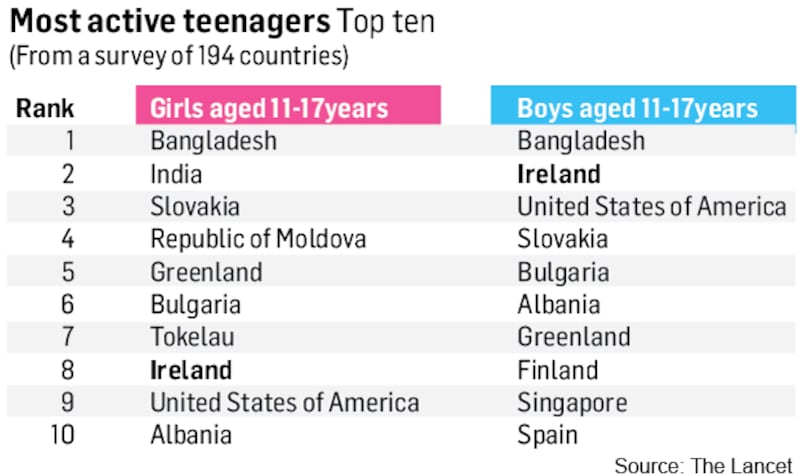Seven out of 10 older schoolchildren in Ireland do not get enough daily physical activity, with inactivity more common among girls than boys, a major international report finds.
Some 71.8 per cent of Irish 11- to 17-year-olds get insufficient physical activity every day, thereby compromising their health, the study published in the Lancet Child & Adolescent Health journal finds.
This figure hides a gender gap of more than 15 per cent – the largest in the world along with the US – between Irish boys and girls. Some 63.5 per cent of Irish boys were deemed to be insufficiently physically active, rising to 80.5 per cent among girls.
The World Health Organisation (WHO) recommends young people get at least one hour of physical activity per day, the yardstick used in the study.
Despite the fact that most of its young people do not exercise enough, Ireland actually ranks as one of the countries with the lowest levels of physical inactivity among 11- to 17-year-olds – third in the world behind Bangladesh and Slovakia and just ahead of the US. Irish boys have the second-lowest levels of physical inactivity in the world, after Bangladesh, while Irish girls rank ninth-best in the study.

Levels of physical inactivity fell 7 percentage points among Irish boys between 2001 and 2016, the study also shows, but they remained unchanged among Irish girls.
Results ‘concerning’
Prof Niall Moyna, of Dublin City University's school of health and human performance, described the findings as "very concerning" and "a call for action".
“Governments will have to take serious action. If they don’t, we’ll see a generation developing chronic diseases at ever younger ages, and requiring multiple drugs to control their conditions.”
Globally, 81 per cent of young people did not meet the WHO recommendation for physical activity, according to the study of 146 countries by researchers in the UK and Australia.
Girls were less active than boys and the gap has grown since 2001 in most countries as more boys become physically active. Girls were more active than boys in just four countries: Tonga, Samoa, Afghanistan and Zambia.
Prof Moyna said “cultural factors” – including showers, make-up and headphone use – needed to be addressed to tackle the gender gap. Girls’ participation in sport “falls off a cliff” by transition year, he noted.
“We have to arrest that decline by engaging girls, and by asking them what they want. What’s wrong with letting a pupil go off walking for 30 minutes every day listening to headphones, for example? For school principals, it can’t only be about Leaving Cert points.”
The health benefits of a physically active lifestyle during adolescence include improved heart and respiratory function, bone health, metabolism, as well as positive effects on weight, cognitive development and socialising. Many of these benefits continue into adulthood.
The study is based on assessments of the physical activity of 1.6 million children, such as time spent in active play, recreation and sports, active domestic chores, walking and cycling or other types of active transportation, physical education and planned exercise.










